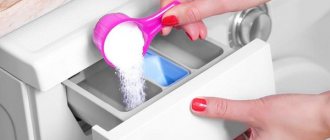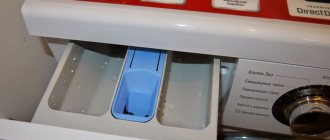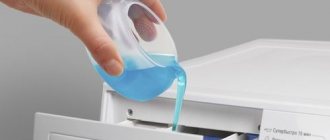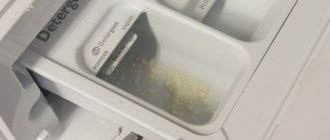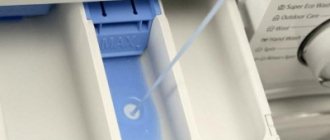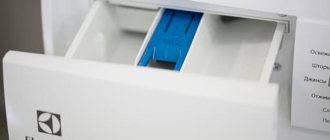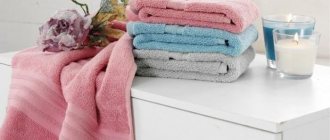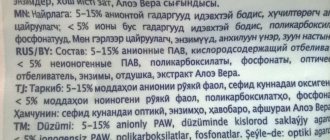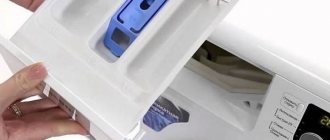In order for the washing machine to last a long time and operate smoothly, it is necessary to handle it correctly. It is mainly important to know where to put the powder in the washing machine and where to add the bleach, stain remover and conditioner.
All modern washing units are equipped with trays designed for storing detergents. However, the chemical industry offers different compositions for washing, both in the form of powders and liquids. There are also special-purpose products: stain removers, bleaches, rinses and others. And often we cannot immediately figure out which compartment of the tray is intended for what.
What types of detergents are there and what are they for?
The range of household chemicals stores is wide and varied, and counters with laundry detergents are full of a huge number of bright boxes and bottles. How to figure this out? The main types of washing compositions can be distinguished:
- powders (intended for main wash);
- compositions in the form of liquids (washing gel, rinse aid, stain remover and fabric softener);
- tablets and capsules (contain concentrated compressed laundry detergent or gel).
Whatever product you use, pay attention to the amount of foam formed. If there is too much of it, this indicates that the dose of the substance has been exceeded and needs to be adjusted. Typically, these recommendations can be found on the packaging of the powder or gel.
It is also important to choose products marked “automatic” for machine washing and pour or pour the selected composition only into the appropriate compartment of the tray.
Use of capsules
Special washing capsules are designed for direct loading into the drum. Under the durable shell of the product there is a concentrated gel. During washing, the capsule gradually dissolves. The gel is evenly mixed with the total volume of water, without eating away stains on clothes.
Liquid products can be poured into the tank provided they do not contain aggressive concentrated additives. This includes various rinses, conditioners, and fabric softeners. You need to know where and when to apply any powder or solution. This is the only way to guarantee high-quality and safe washing.
What does the washing powder tray look like and where is it located?
In different models, the container for powders and liquids is located differently. If your washing machine has a vertical loading of laundry, then this compartment will be located on the inside of the hatch; in front-facing machines it is located on the front or rear panel.
The tray consists of 3 parts of different sizes, each of which is marked with icons (different models may have different markings). When loading detergents, you need to focus on these indicators. So what does the tray look like? When you open it, you will see the following:
- the widest compartment is marked with B, "2" or II;
- the medium-sized part of the compartment is designated by the letter "A", the Arabic numeral "1" or the Roman I;
- the smallest part of the container is indicated by an asterisk or a flower, and may have the inscription Softener.
Once you've found the tray and examined it, it's time to figure out which part is for which products.
Determining the optimal amount of funds
Depending on the selected program, the following products must be added when washing products:
- For simple washing, just pour the powder into the cell marked with the letter B or the number 2 (II).
- For a full cycle with soaking and rinsing with the addition of softener, powder is loaded into compartments A and B, and conditioner is poured into the tray marked with 3 or a “flower”.
- If the laundry is not heavily soiled, you can do without pre-soaking. In this case, it is enough to add detergent to compartment B (II); If desired, rinse aid can also be added to the small compartment.
Conditioner (fragrance, rinse aid) can be poured into the tray at any stage of the process until the start of the final stage (rinsing and spinning).
What affects the amount of powder?
The amount of detergent required for washing depends primarily on the volume of items loaded into the machine.
In addition, factors such as:
- degree of soiling of the laundry;
- hardness of water;
- amount of water required for washing;
- selected program;
- washing technology.
The more stains on the products, the higher the consumption of detergent. If the stains are complex, it is better to use a stain remover or bleach.
An alternative to industrial water softeners can be a few tablespoons of baking soda, which is added to the powder compartment. You just need to keep in mind that this product should not be used when washing wool and silk items.
Washing in soft water requires less powder than in hard water. To determine what type of water is in your region, just look at the transparent window when you start washing. If bubbles are visible on it, it means that soft water is flowing from the taps.
The liquid can be softened artificially by adding a special product containing phosphates to the washing powder. A large volume of washing water implies an increased content of detergents.
Different modes involve the use of a certain amount of washing powder. In some cases, the difference can be striking: for example, when washing 3 kg of laundry in the “Cotton” mode at +60 °C, 6 tablespoons of detergent will be required, whereas when choosing the “Synthetics” program at +40 °C, only three are required.
It is also necessary to use liquid gel in a certain amount. Increasing the laying rate only leads to wasteful use of the product, while the quality of washing remains unchanged
Innovative solutions used in modern models of washing machines from the best manufacturers can reduce the consumption of electricity, water, and detergents.
Such technologies include:
- “smart bubbles” EcoBubble;
- steam wash.
In the first case, a special foam generator is used, with which the powder is mixed in water before it enters the drum. Under the influence of bubbles, the product penetrates better into the fabric structure, effectively removing dirt, which helps save powder.
Steam washing involves applying a heated jet of water to items placed in a drum. This technology promotes the rapid dissolution of detergents and the effective removal of contaminants, including old ones.
In this case, the water temperature is chosen arbitrarily; it does not necessarily need to be heated to high temperatures. Important advantages of steam washing include the radical destruction of germs and allergens.
Where to put powder in the washing machine
If the markings on the machine are not visible, you can use the dimensions of the tray compartments as a guide. You need to pour washing powder into the machine into a larger tray marked “B”, “2” or II. Liquid compositions or cleaning solutions in the form of shampoos cannot be poured here.
Additional icons
They mark modern models of washing units.
- Drying – image in the form of a sun. Present in machines with built-in clothes dryer. The mode is used for almost all types of fabrics.
- Delayed start – “timer” inscription, clock dial, number “24”. The mode allows you to delay the process for a specified time.
- Eco wash or economy mode – tree icon or letter “e”. Less water is used. The drum rotation speed is also lower.
- Stain Removal - There is a black stain on the T-shirt. The laundry is soaked using foam.
- Night cycle – moon/stars. Reduced noise generation.
- Lock/child lock – picture of a lock.
- Washing sportswear – mountain pattern, “outdoor”.
- Foam control - image of soap bubbles.
We suggest you read How to wash a bloody mouse pad
Is it possible to pour powder directly into the drum?
Disputes on this issue between housewives have not subsided for a long time. Women's opinions were divided. Some argue that putting powder directly into the drum will help save detergent without in any way affecting the quality of cleaning things. In other words, the detergent composition immediately reaches the laundry without passing through the unit, which allows it to be used in smaller quantities.
Others argue that the savings are mythical. Since most of the product is washed out with water, which is poured and drained into the drum several times during the washing cycle, the powder does not have time to foam and remove dirt from the clothes. Therefore, some housewives consider this method of backfilling to be ineffective, allowing its use only in a situation where the tray is broken or cannot be used for other reasons.
Whether it is worth pouring powder into the drum is up to each housewife to decide for herself. But whatever filling method you choose, use only automatic washing powders and follow the recommended dosage of the product.
Pouring detergents into the drum
After prolonged use, the washing machine begins to leave some of the unselected powder from the loading tray compartment. The problem is due to the nozzle and water supply hose being clogged with solid deposits or rust. Not removing all the powder impairs the quality of the wash. The problem is solved by pouring detergent directly into the drum onto the laundry before starting washing.
Manufacturers of household appliances do not recommend direct powder filling in the following cases:
- When washing dark and colored clothes, the concentrated granules will dissolve in one place. Light spots that have eaten away the paint will appear on the laundry. Some of the clothes will generally remain dirty. Liquid detergents will be immediately absorbed into the area of dry clothing. Stains are 100% guaranteed, and most of the laundry will remain unwashed.
- To avoid stains, housewives pour the powder into an empty drum and then load the laundry. Through the holes, the detergent enters the tank, where it dissolves when water is supplied. However, when starting any washing program, the machine first pumps out the remaining old liquid with a pump. Some of the powder goes down the drain along with dirty water. The result of further washing will be negative.
- You cannot pour powder inside the drum if the washing mode is based on the gradual withdrawal of detergent from the tray cell.
However, if the powder intake from the dispenser is poor, you should not refuse to wash delicate and dark items. The detergent is placed inside the drum, but after pouring it inside a special container.
The device resembles an ordinary plastic jar with small holes. The container acts as a dispenser. The plastic container is washed along with the laundry. Streams of water gradually wash away the already dissolved powder, which in low concentration does not harm the laundry.
The price of containers is low. You can buy several of them for different types of detergents. Additionally, special rubber balls for washing are thrown inside the drum. Spikes on the surface of the balls help to better get rid of stubborn dirt.
Where do you put gel capsules or laundry tablets?
Not so long ago, laundry detergent compositions in the form of capsules or tablets appeared on the household chemicals market. The capsule, as a rule, contains the product in the form of a gel, while the tablet is a compressed powder that gradually, layer by layer, dissolves during the washing process.
To ensure that your washing machine serves you for a long time and also cleans your laundry efficiently, follow the rules of its operation and you will free up a lot of time while your assistant deals with stains and dirt on things.
Can you bleach things with bleach?
You need to be careful when using bleach or bleach. This substance is very aggressive, so it is not suitable for all types of fabric. It copes best and safest with yellowness and stains on cotton products; It is worth remembering that frequent bleaching spoils the item.
Interesting materials:
What can you do to stop ads from appearing on your phone? What can be done to prevent the windows on the balcony from freezing? What can be done to solve the acid rain problem? What can you do to stop your dog from barking? What can be done to reduce environmental pollution? What can you do to turn on a laptop without a battery? What can be done to preserve nature? What can be done to protect the environment? What can you do if the bread has dried out? What can you do if your swimsuit has faded?
How much washing powder is needed for washing?
Any bleach makes things cleaner, eliminates grayness and yellowness. Therefore, it is added to the washing machine. But not all bleaches can be poured into an electromechanical washing device.
Today we will tell you what bleaches can be used for automatic washing.
We will also advise you on how to use and where to add bleach in the washing machine.
Symbols and purposes of machine compartments
In a Samsung washing machine, the tray is divided into several compartments: each performs its own function and is designed for a specific type of detergent. Below is a table that contains transcripts for each department:
| Compartment type | Purpose |
| A or I | Used to add washing powder, as well as liquid-based products, if the mode includes pre-cleaning of clothes. It is allowed to introduce products for whitening and stain removal. |
| B or II | You can put powder and other detergents into the compartment to perform the main wash. |
| Star | It differs from the previous compartments in its small dimensions. Designed for rinse aids and conditioners. Used when the cycle is approaching the last rinse. |
It is not recommended to place stain removers and bleaches in the drum with clothes. This can cause rapid damage to things in any selected mode.
If the markings are erased, it’s not difficult to guess where to put the laundry detergent. Almost all Samsung models have a universal location system:
- on the left is a tray for standard washing, where you can pour powder;
- in the middle there is a compartment for a linen freshener;
- The section on the right is suitable for pre-soaking.
If it is difficult to understand such a scheme, then you can refer to the instructions, where the diagram of the trays is shown in the figure.
Types of bleaches for automatic washing machines
There are chlorine-containing and oxygen-containing bleaches.
One of the common chlorine bleaches is “Whiteness”.
“Whiteness” has a number of advantages:
- effective whitening even in cold water;
- cheap product;
- ease of use: does not require boiling, easy dosing;
- disinfects and successfully removes stains.
Oxygen-containing bleaches
They are a solution of hydrogen peroxide. In addition to this, their composition includes: active surface substances, stabilizers, fragrance, optical brighteners, Ph regulators.
Pros of oxygen-containing bleaches:
- The main advantage of peroxide bleaches is their use not only for cotton and linen fabrics, but also for wool, silk, and synthetic materials.
- Colored fabrics become brighter and fresher when using oxygen bleaches, dirt deposits are washed off, and dyes do not deteriorate.
- They can be used without fear of reaction of chemical elements with any washing powder.
- The hypoallergenic nature of oxygen-containing bleaches makes them superior to chlorine bleaches because they do not harm the human body.
- The products also have disinfectant properties.
They are sold in both liquid and powder form.
Peroxide bleach solutions are short-lived: when stored for a long time, they lose their beneficial properties; in powders they last much longer.
Powdered oxygen bleaches make laundry white at a temperature of at least 60 degrees. And delicate fabrics and colored linen can lose their original appearance at high temperatures, so for colored linen it is better to use liquid peroxide bleaches, which are much softer than powdered ones and are gentle on colored and delicate linen, do not destroy the fabric or spoil the design.
Optical brighteners
Optical brighteners are another category of detergents that improve the cleanliness of fabrics. But it should be noted that their whiteness is apparent, which is given to clothing by the luminescent dyes included in their composition.
The disadvantages of chlorine bleach are:
- aggressiveness: over time, the material tears and turns yellow;
- Do not bleach wool, silk, or synthetic fabrics;
- negatively affects metal and rubber. To prevent the aggressive substance sodium hydrochloride from corroding the packaging, Belizna is packaged in plastic bottles at production;
- Some women cannot tolerate the smell of bleach: it causes an allergic reaction in them;
- when interacting with some washing powders, “Whiteness” becomes more aggressive, which causes corrosion of the fabric.
Before deciding whether chlorine bleach can be used in a washing machine, you need to look at the instructions for a particular brand.
In general, chlorine bleach is not used for automatic washing. The instructions for each model say whether it can be used or not. If the device has four compartments, this means that it is suitable for “Whiteness”.
In machines where rubber pipes are replaced with plastic ones and the drum is made of high-strength material, we use chlorine bleach.
Instructions for using chlorine bleach in the washing machine
If, however, chlorine bleach can be used in a washing device, then you need to act according to the instructions for use.
- First of all, inspect the clothing and remove all metal parts. If they cannot be removed, then do not use bleach for automatic washing, because it will darken the metal.
- Wet the items and put them in the drum.
- It is better to pour “Belizna” into a cuvette: 125g of the product if a small amount of laundry is placed in the drum and 250g when the machine is fully loaded. The exact dosage is: one tablespoon per liter of water.
- Add washing powder. It is needed for simultaneous washing and bleaching.
- But, if you decide to pour chlorine bleach into the drum, then before doing this, dilute it in a large amount of water so that the aggressive substance does not spoil the laundry. But it is best to pour it into a container so that the effect on clothing is uniform.
- Set the “Stain removal” mode. The washing temperature should be no more than 45 degrees.
- If there is no need for washing, then set the “Rinse” mode.
- You need to rinse your laundry several times after bleaching.
- Wring out the laundry.
Where to pour bleach in the washing machine
The washing machine has a container for pouring any bleach and washing powder. In modern washing machines, the container mainly consists of 3 compartments. It is important to know exactly what each compartment is intended for and what detergent you need to put in it.
Washing devices have a retractable or removable container. If the washing machine has a horizontal loading, then the tray is located on its front or top panel.
If the device model is vertical loading, i.e. the hatch is located on top, then the container is located on the inside of the lid. Basically, the tray has a button that helps you remove the compartments and wash them.
Let's look at what kind of compartments these are and which compartment of the washing machine to pour bleach into.
One of the compartments, the smallest, is for rinse aid. There is a restriction strip on the compartment. In most cases, the sector contains the inscription: “Max”.
Custom Manufacturer Badges
Some manufacturers use not only standard, but also their own icons to indicate certain functions. We tried to consider the most common of them.
Samsung
The brand has chosen letter designations for the modes. After reading the name of the program, the user will immediately understand which fabrics should be washed in this mode. Several symbols are shown as pictures:
- timer – image of a clock;
- stained clothes - intensive wash;
- face with lock – protection from children;
- clothes and soap bubbles – cleaning with bubbles;
- basin with a wavy stripe - soaking laundry.
On the panel, symbols are divided into groups. You can choose the spin level and additional functions. Location and markings of symbols:
- the on/off button is located in the center of the panel;
- clothing and underwear – cotton program;
- clothes on hangers - cleaning synthetics;
- trousers – program for jeans;
- basin with a strip - cleaning in a large volume of water;
- iron – delicate mode;
- A skein of wool in a bowl - manual program and woolen items.
Zanussi
The rotary wheel on the panel allows you to select the type of wash and temperature mode:
- cotton picture - for natural things;
- flower – delicate wash;
- knitting threads - for woolen items;
- triangle – synthetic;
- basin facing down - drain;
- spiral line – spin;
- bowl with dots – rinse mode icon;
- Hand in bowl - hand wash.
Indesit
The manufacturer indicated its name and number next to the mode:
- a cotton box means washing things made from natural fabrics;
- triangle – washing synthetics;
- curtains – cleaning curtains;
- wood – economical mode.
There are no icons on the units of this brand; instead, there is a letter name. Use the rotary knob to select the desired mode.
Hotpoint-Ariston
There are program descriptions on the powder tray. They are slightly different from other manufacturers:
- a basin with liquid and a vertical strip - soaking things;
- bowl with waves and dots - rinsing;
- month with stars - work in night mode without draining, with reduced noise generation;
- empty basin with a vertical stripe - pre-treatment;
- arrow and two stripes – pause, start;
- sheets and pillowcases – bed linen washing;
- “M” – “my program” mode. The most frequently used programs are added to the device memory.
We suggest you familiarize yourself with Checking and replacing the pressure switch in a dishwasher
Electrolux
Most of the icons coincide with the generally accepted ones. There are individual ones intended only for this brand:
- butterfly – cleaning silk products;
- image of a blanket - bedspreads made of different fabrics;
- sneakers – for sportswear;
- snail – spin;
- shirt – treatment of no more than five slightly soiled shirts.
Electrolux
- bowl with two vertical stripes - normal mode;
- basin with the letter “R” and horizontal lines – fast program;
- T-shirts – everyday use;
- pen – delicate program;
- pelvis with two waves - intensive mode;
- dial image – delayed mode;
- crossed out snail – without spinning;
- watering can with drops - rinsing;
- two watering cans with drops - additional rinsing.
Now, having understood all the variety of symbols, Nastya can choose the ideal mode for washing her clothes.
How to use "Whiteness"?
Users are worried whether the washing machine itself will be damaged by the aggressive product? What if it corrodes some parts? There is no clear answer. To find out whether “Whiteness” is dangerous for the washing machine, you need to read the instructions: if the use of chlorine-containing solutions is prohibited, it will say so. Typically, “Whiteness” is prohibited from being used in SMA.
Devices in which the use of chloride compounds is permitted are equipped with plastic pipes and drums made of durable materials. You can also find out about the possibility of using products with chlorine by indirect evidence. Look into the cuvette where you are used to pouring powder - if there is an additional fourth compartment, then use is allowed. Bleaching is not recommended to be used too often - it can damage parts that come into contact with the chloride liquid.
But occasionally, such an event will be useful for the washing machine itself: chlorine-containing preparations will not only bleach things, but also kill the microbes inside and eliminate putrid and musty odors.
What is the danger and why not?
If a washing machine manufacturer insists that the powder goes into a container for it, there is a reason for this.
If the headset door does not open at least 90 degrees, it is difficult to open the tray
First, let's figure out what happens in the dispenser. After starting the wash, the first thing you can hear is the sound of water at the top of the machine. This water is supplied under pressure into the cuvette. There she dissolves the powder and picks it up, sending it into the drum. The solid powder structure dissolves in this short time and, together with the foam formed under the pressure of water, is supplied directly to the place of the “incident” - to the laundry.
Therefore, it doesn’t make much difference for the machine where you are going to put the product - in the cuvette or on your clothes. But for your clothes, such a wash may be the last - a large granule, without dissolving, can put a stain on your favorite blouse. And if the composition contains bleaches or other aggressive agents, stains may also form. If loaded correctly, this will not happen - the evenly dissolved liquid will be gentle on the clothes.
This is what stains from colored granules look like
If you are wondering where to pour the granules for reasons of washing quality, then you can send it to the machine in a special ball with holes. This could be a homemade jar or capsule. There will be no contact with the detergent, and the clothes will not be damaged.
Dispenser with a measuring scale - most often found on sale
How to bleach gray laundry?
- Inspect items to be processed. Remove all metal accessories, if any. It happens that parts are not removable, then chlorine liquid is not suitable - take liquid without chlorine. Because of the latter, the metal darkens.
- Soak items in cold water and place them in the drum.
- When there are few things, 250 g of “Whiteness” is enough. Open the cuvette and look carefully at where to pour the bleach. It is allowed to add washing powder at the same time - if things need to be washed at the same time.
- Select a program with temperatures up to 45 °C. Can be whitened in rinse mode.
- Rinsing after treatment in a bleaching composition is carried out twice: it is important to rinse the laundry thoroughly to get rid of traces and the smell of the chemical substance. It is recommended to use air conditioning.
- For delicate fabrics, washing with bleach should not exceed a quarter of an hour. Watch the process so that things are not damaged.
Special powder receptacle compartment
The latest models of washing machines are equipped with a separate compartment for bleaches, indicated by a triangle icon. To understand whether your equipment has such a cuvette, you need to study the instructions, find the compartment, pull it out and fill it with white in the required dosage. It is worth paying attention to o, which will help not to overfill the product.
The bleach compartment is marked with a triangle.
You can pour bleach directly into the drum. The main thing is to pre-mix the measured amount of liquid with 3-4 glasses of water so as not to spoil the washing machine tank. You should also be careful with things: you should not splash the product on the fabric - this is detrimental to textiles. It is better to add white to the bottom of the empty cylinder, then rinse off the caustic substance with clean water, and only then load the clothes.
Why do things spoil?
In order for the laundry to remain unharmed after treatment with “Whiteness”, it is not enough to know where to pour the product, you also need to know how to use it correctly. In case of violation of the rules:
- wear and tear of things accelerates;
- materials become thinner and worn out;
- things tear, holes appear on them.
Experts do not recommend using bleaches in SMA at all. But experienced people assure: it’s all about the technology of use and the correct dosage. If you do everything correctly, you can get rid of any stains, whiten fabrics and not damage the machine at all.
Let's use the Whitening program
Many “advanced” modern washing machines offer the user a special program – “Bleaching”. If there is one, then if you want to wash with chlorine, you should turn on this mode for better results. It's easy to use.
First we erase the main loop. We sort the laundry, group it, and then load it into the drum, add powder to the main cuvette of the tray and activate any suitable mode.
As soon as the cycle is completed, without removing the laundry from the tank, we begin bleaching. Necessary:
- add bleach to a special cuvette (marked with a triangle icon);
- turn on the Whitening program.
The machine will do the rest itself: set the temperature and cycle duration. All that remains is to wait for the end of the program, evaluate the result and, if necessary, repeat the procedure.
Useful tips
Recommendations for hand washing:
- To maintain white color. Dilute two tablespoons of “Whiteness” in 10 liters of water. Mix thoroughly. Soak white items for 20 minutes. Rinse and wash.
- To eliminate gray tints, spots, yellowness. The solution is prepared in the same way as the previous one, but soaking lasts three times longer - a whole hour.
- For thick fabric. The undiluted composition is applied to problem areas. Wait no more than a minute and soak everything in the same solution for 60 minutes. Then wash by hand.
Recommendations from experienced housewives and experts regarding whitening in SMA:
- Pour the product not into the compartment, but directly into the drum - then fewer elements of the washing machine will come into contact with the aggressive liquid.
- Before pouring into the drum, be sure to dilute the chlorine-containing compound. Look at the label - it indicates in what proportions to dilute. Linen is soaked in cold water before washing.
- Before starting the process, it is advisable not to be lazy and check the drum’s susceptibility to bleach. Wet a rag and rub the drum with it - look at the result. If there are no changes, apply.
- Do not bleach in too hot water: this will have a bad effect on the machine and laundry.
Main images/icons
The principle of the location of the symbols is simple - they are located next to the button, by pressing which, for example, you start a washing program, or around the knob, by turning which you select the desired function or mode.
In the photo you can see buttons with on/off, as well as start and pause icons
There are icons whose meanings users can decipher intuitively and those that are the same for most units. These include:
- a circle with a vertical line at the top is an icon for turning the machine on and off;
- a triangle and two vertical lines, indicating, respectively, the start of the program and a pause in its execution (start/pause);
- a snail or a twisted spiral - a spin icon on a washing machine;
- a snowflake, which is usually used to indicate washing or rinsing in cold water;
- a basin with water, as a rule, corresponds to the wash itself and can be supplemented with other symbols, for example, the manual mode is depicted as a basin with a hand, the pre-wash is a container with one vertical line inside, the main wash is a basin with two vertical lines;
- the rinse icon on a washing machine, which is often represented by a picture of a container filled with water;
- a basin with a vertical arrow pointing down, depicted next to the button responsible for draining the water.
Let's summarize this information in a table:
Rinse in cold water
Drain or Empty
Often, different models have the same designations for the main washing modes and types of fabrics:
- cotton fabrics are depicted in the form of a cotton box, synthetic ones - with a test tube with a spout, woolen ones - with a skein of yarn, denim ones - with a pattern of pants;
- intensive washing can be identified by the image of items with stains;
- delicate washing is often indicated by the image of a flower, and economical by a tree.
The photo shows a decoding of the most common and universal symbols used on the panels of washing units
It should be noted that the number displayed on the display usually means the number of minutes remaining until the selected washing program is completed. In modern models of units, most of the symbols are also displayed on the liquid crystal display: by looking at it, you can find out about the parameters of the selected washing mode (number of spin speeds, temperature indicators and some additional functions) and what stage the program is at (for example, if the spiral icon, this means that the machine is spinning).
Icons appear on the display to help you determine which wash cycle is currently running.
In older models, almost all information about the selected mode and its current stage can be obtained from the signals of small lights on the dashboard (indicators) - the lights will light up next to the corresponding images.
A button with a thermometer icon allows you to select the desired water temperature
The button with the words Eco/Eco Perfect or the letter E starts the economical wash program
The basic functions of the vast majority of washing machines are the same, therefore their designations are basically the same, but differences still exist.
Features of using bleach
When working with aggressive chemicals, it is important to follow safety rules - not only sheets and washing machine parts can be damaged, but you too. Safety rules when working with chlorine-containing solutions:
- When bleaching, wear gloves and a mask. Contact of the substance with the skin causes burns, corrosion, and allergies.
- It is not advisable to use a stain remover on colored fabrics - the stain will come out, but along with it the color will lose its saturation.
- Do not use on leather, wool and silk items. Stains from them are generally very difficult to remove; compositions with chlorine will only spoil the material or cause the appearance of yellowness. Use is allowed on cotton, linen and synthetic fabrics.
- If the container with “Belizna” has been opened for a long time - six months or more, it is not worth using it, since the chemical effect of the composition is noticeably reduced.
Its types
Liquid type powders are divided into several groups:
- Products for specific types of materials: silk, wool, lace, denim, guipure, chiffon and so on.
- Products for dark, white or colored items. These powders allow you to maintain the original characteristics of the products: whiteness, color saturation and brightness. Products in this category are presented in the Tide product range.
- Universal liquid powders can be used to wash items of any color and made from different fabrics.
- Gentle products for sensitive skin or baby items. They do not contain aggressive components that can irritate the delicate skin of a child or person suffering from dermatological diseases. Such products are available in the Ariel range of liquid powders.
- Hypoallergenic liquid powders are suitable for allergy sufferers, as they do not contain additives that can cause unwanted reactions.
- Stain removers, for example, Vanish. They can be used to remove stubborn or old stains that conventional detergents cannot remove.
According to the form of release, the products are divided into gels, packaged in bottles (the caps of some have a convenient measuring scale) and packaged in capsules. The latter are simply placed in the machine and begin to operate when the drum rotates.
Where should I put the stain remover?
Along with bleaches, users often use stain removers. They are poured into a container for washing powder. Thanks to stain removers, you can remove any stains from fabric. Advantages of modern stain removers:
- versatility - removes any dirt;
- practically no foaming;
- environmentally friendly - do not provoke skin irritations;
- effective in cold water;
- suitable for any fabric.
If you follow the rules of use, “Whiteness” can be beneficial - there is nothing difficult to use. The main problem is its chemical aggressiveness, which can harm not only laundry and the washing machine, but also humans. Now there are enough more effective and safe drugs that can successfully replace the product that our grandmothers used.
How do you bleach laundry?
When washing, you can use different types of bleaching agents:
- Based on active oxygen.
- Chlorine bleaches are cheaper bleaches. They are more aggressive and can cope with the most advanced situations. Housewives use chlorine-containing products to restore the snow-white color even to gray and faded linen.
The most popular bleach is “Whiteness”. This is a potent composition that can act not only on contaminated fabric surfaces, but also on metal and rubber. But chlorine solution is not harmful to plastic, which is why it is sold in plastic containers.
Should I fix it myself or call a professional?
There are many reasons why a leak may appear during spinning or rinsing. You can deal with some of them yourself (regular cleaning of the powder compartment, dirt filter). But if the breakdown is serious, the components (pipe, bearing, valve) need to be replaced or repaired. In this case, contact specialists who know all the nuances of the washing machine.
If, when filling, water leaks simultaneously in several places, you hear grinding and excessive noise, or you discover a leak, call a specialist immediately. The technician will not only be able to figure out the reasons for the leak, but will also replace important elements, fix the breakdown and tell you in detail about the reasons that led to the malfunction of the washing machine.
The professionals of our workshop are always in touch. We approach repair work with full responsibility and guarantee the quality and operation of household appliances without failures.
Removing the machine from dirt and odor
The primary task of Whiteness is to rid the machine drum of the unpleasant musty smell that constantly plagues SM users. Moreover, such behavior can be caused by any careless action or neglect of the recommendations of specialists. Moreover, if you do not pay attention to this unpleasant symptom in time, the situation will only worsen, and you will have to take urgent measures.
As they say, it is easier to prevent a fire than to put it out. So here too, it is better not to bring the machine to a state where everything within a radius of two meters around it “smells” of mustiness. Here are the primary reasons for this phenomenon.
- Some housewives neglect special baskets for dirty laundry and put used clothes directly into the drum. Due to high humidity and the presence of bacteria, the smell begins to intensify and spread extremely quickly.
- An unpleasant smell will not be long in coming if you never ventilate the drum after washing. As soon as you close the door immediately after finishing work, the next time you are faced with a terrible stench from inside.
- The quantity and quality of household chemicals can also leave an impact. For example, if you pour or put too much powder or rinse aid inside or use low-grade products. In this case, fungus will begin to appear inside the machine, which will lead to the appearance of mold with a characteristic aroma.
These measures will help to avoid contamination and jamming of the machine if you start taking them on time. If the situation is already out of control, and measures need to be taken urgently, Whiteness can really have a miraculous effect. How to achieve it?
- First, pour a liter of White into the powder compartment.
- Start washing at the highest temperature possible. As a rule, it is 90-95 degrees.
- Wait until the machine door becomes quite hot and pause the wash. Now go about your business for a while.
Attention! To get rid of an unpleasant odor with the help of Whiteness, you need to wait at least two hours, otherwise all your efforts will be in vain. Although bleach is a strong chemical, it is not able to kill all colonies of bacteria in five minutes.
- After the required amount of time has passed, drain the water from the machine and turn on the rinse, while simultaneously pouring a little vinegar into the washing compartment.
- After the wash is finished, run the rinse cycle a few more times to remove the smell of chemicals and vinegar.
Lack of compartment markings
Sometimes it happens that the markings on the compartments are erased. The question arises, how in such situations to determine which detergent and where to pour or pour. The purpose of each compartment can be determined experimentally. To do this, open the tray capacity halfway. Start the machine by turning on the program with the longest cycle. It will consist of soaking (pre-washing), the main washing stage, and a rinsing operation.
Differences in the design of trays between different manufacturers
In most cases, the number and location of cells for detergents and care products is standard: 3 containers in a pull-out cuvette.
But there are exceptions:
- LG sometimes only offers 2 compartments (in older models). Soaking products (small compartment on the right) and care products (insert) are loaded into one compartment.
- The main difference between Indesit is the cuvette for bleaching substances, which has a compartment for liquids and bulk or concentrated (thick) products.
- Some Samsung models have an additional compartment in the prewash compartment. It is designed to load bleach. If the cell is not removed, the pre-soak program cannot be started.
- Most Bosh machines have a starch compartment added. Starch can only be loaded into the cell in the form of a solution with water.
If the location is atypical, markings will help you understand the compartments of the tray for loading household chemicals.
Is whiteness harmful to the typewriter?
In order to settle this issue once and for all, an experiment was conducted. 15 liters of Whiteness were poured into the drum of a washing machine, which was far from new. Then an armful of rags was loaded into the unit and the wash started. It is worth noting that the SM was disconnected from the water supply, which means that the rags were washed in concentrated Whiteness.
After completing the disinfection process, the experimenters checked the insides of the machine, even the smallest parts: rubber bands, pipes. Everything was in perfect condition, not a single element was damaged, which, of course, could not be said about the rags. But the fact remains that it is safe to use white for SM.
Differences for machines with different loading
A significant difference between top-loading and horizontal-loading washing machines is the location of the tray with cells for detergents, bleaches and softeners.
For units with vertical loading, the container is located directly in the hatch . The downside of such models: you won’t be able to add the product after the program has started; you can stop it temporarily. In modern models, manufacturers have added a reloading function.
For washing machines with side (horizontal) loading, the container for household chemicals is located in the upper left corner of the front wall. You can open the retractable cuvette at any stage of the wash cycle.
Industrial whitening products
Optical
This is a certain chemical compound capable of reflecting light, this effect is achieved thanks to special dyes that do not wash off when rinsing. And when they come into contact with something sunny, they reflect a bluish tint.
One of the main disadvantages of this product is an allergic reaction. Therefore, they are categorically not recommended for use on children's clothing.
Oxygen
Oxygen bleaches are available in two forms: liquid and powder, perfect for both cotton and delicate fabrics. They are made on the basis of one of two components - carbonate or carbonate peroxyhydrate.
During the splitting process, it breaks down into soda (which has a bleaching effect) and peroxide (which can release oxygen). With the help of which dirt is more effectively separated from the texture of the fabric.
The most popular representatives of this product:
- Bos OXI,
- Vanish oxy.
- Soap nuts.
- Sarma active.
- Persol.
On the packaging of oxygen bleaches, as a rule, the markings Oxy, O2, Active, Oxygen are indicated.
The main advantages of this tool:
- Works great at low temperatures, 40 degrees is enough.
- Does not harm delicate materials.
- Capable of removing old stains.
- Wash well.
- Rarely cause allergic reactions.
- There are compositions for white and for color.
- Removes almost any pollution.
Their main disadvantage is their rather high cost and high consumption.
We suggest you familiarize yourself with How to remove double-sided and regular tape from a car (from a car body, dashboard, glass, plastic), how to remove traces and remove adhesive tape?
Chlorine
A fairly reliable and proven product, the active ingredient is sodium hypochlorite, the main advantages include:
- Ability to remove almost any contaminant.
- Affordable price, these funds are budget ones.
- It has an antibacterial effect, as a result you get clean laundry without germs.
Despite all the advantages, there are also disadvantages, since the product acts quite aggressively on the structure of the material, it can only be used for cotton. It is very important to protect yourself from exposure to its fumes; the room should be well ventilated, and you should wear gloves on your hands. The most popular representatives are bleach, whiteness, and Domestos.
How to choose an operating mode?
The Hotpoint-Ariston brand has been developing and producing washing machines for many years. The previously primitive unit has evolved over time into a multifunctional device with software. The control panel of such a device is different from similar ones. It contains graphic symbols, names of programs and washing modes. In order to correctly select the operating mode of the washing machine, you must first of all learn to decipher the information on the panel.
Let's look at all the washing modes that the Hotpoint-Ariston washing machine has; they are divided into three groups.
Daily use
Name
Designation
Washing duration
Divided into several types:
Washing time for each type:
Washing heavily soiled and lightly soiled items. The washing temperature is different. Spin – 800 rpm.
Article on the topic: Where are Zanussi washing machines assembled?
Mix 30 (quick wash 60)
Designed for washing not very dirty clothes or refreshing new ones.
Mix 15 (quick wash 30)
Select this mode to refresh your laundry.
Special Modes
Name
Designation
Washing duration
Consists of two programs:
- heavily soiled underwear;
- colored linen.
Spin mode 1000 rpm.
Silently washes things at night, while consuming a minimal amount of electricity.
4 hours 50 minutes
Children's underwear is washed at a temperature of 40 ºС.
Gentle washing mode, temperature does not exceed 30 ºС.
Wash at a temperature of 40 ºС, minimum drum speed – 600.
Additional modes
The washing machine is equipped with additional functionality - “My program”, “Rinse mode”, “Normal spin and delicate”, “Drain”. The choice of operating mode for a household appliance depends on the type of items that will be placed in the washing drum. It is very important, before turning off the machine, to carefully inspect each item, paying attention to the tag. It contains the following information: the type of fabric from which the item is made, the permissible maximum washing temperature, what detergents and bleaches can be used. That is, it is suggested which washing option to choose.
You should understand that, for example, if you wash a silk blouse in the “Cotton” or “Synthetic” mode, unfortunately, you will have to say goodbye to it. Before each new wash, you need to reset the preliminary settings, turn off the delay timer and then select the desired mode.
What happens if you don’t clean the washing machine drum?
If you refuse such a simple procedure, you may end up with unpleasant consequences, for example, breakdown of the unit followed by expensive repairs. The service life of a washing machine is approximately 10 years. But if you do not follow simple care rules, then due to the formation of greasy deposits, mold, and scale, it will not last even 3-4 years.
Lack of care can result in the following problems:
- Dirt and grease will begin to collect on the hose and pipes. This will end with the drain system becoming clogged and the pump impeller blocking.
- A layer of scale will accumulate on the heating element. Over time, it will increase in volume, and as a result will cover the entire heating element. Such a shell of scale will lead to overheating and failure.
- Sand, scale, and rust will begin to accumulate in the place where the inlet filter and hose are connected. Such debris will lead to clogs and leaks.
- Mold and unpleasant odor that appears in the drum will affect the quality of the wash. If you leave wet laundry for 2-3 days, fungal spores will instantly penetrate the fibers of the fabrics, and even after cleaning, dark spots of mold can be seen on the clothes.
Now we can safely answer the question whether it is possible to clean the drum of a washing machine with White. This is an inexpensive chlorine product that can be used to easily get rid of problems with your washing machine. The most important thing is to adhere to the specified dosage and always ventilate the drum after the procedure to remove moisture.
